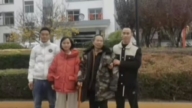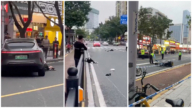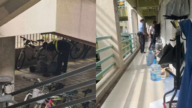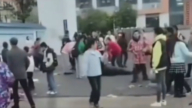【新唐人2011年12月7日讯】温州动车特大事故调查报告迟迟不出,按照相关规定,报告最迟11月30号必须提出,但这一天,相关部门并没有发出只字词组。据报导,事故调查结果难产,是因为高层对责任认定难以取舍,如果说是设备的问题,那么对高铁形象不利﹔说是管理的问题,那么涉及的责任人又太多。
据规定,重大事故调查报告应在120天内公布,现在距离“7•23”甬温线动车特大事故已经四个多月,调查报告仍然没有对外公开。
当事故发生后,铁道部原本已承认信号系统存在问题。7月28号,上海铁路局局长安路生,他在温州举行的第一次事故调查全体会议上表示,“7•23 ”动车事故是由于温州南站信号设备在设计上存在严重缺陷,遭雷击发生故障后,导致本应显示为红灯的区间信号机错误显示为绿灯。
而负责设计信号设备的“北京通号院”也在网站上发布道歉信,表示将“迅速做好整改工作”。
但是,国务院事故调查专家组副组长王梦恕11月20号接受《京华时报》采访时透露,事故调查报告已在9月底完成并递交,他说,“经过调查和实验,动车信号技术和设备可以说没有问题,最大的问题是人员和管理的问题”,他还说,“那么好的设备交给他们(当地管理部门)没有好好管理和使用,造成设备坏掉了。设备坏了之后,人工操作也出现问题。”
不过,王梦恕很快改口,表示那只是他个人的看法,不是调查报告内容。
那么,动车事故发生的真正原因是什么?
大陆媒体指出,导致动车追尾事故发生的原因,既有信号设备软件设计缺陷,也有调度指挥管里的失误。实际上,事故暴露出铁路多个部门都存在问题。从信号设备提供商,到上海铁路局调度所和温州南站行车值班员的行车处理,以及电务部门的维修、登记等。
大陆作家荆楚:“反正是党国专门搞豆腐渣这样的事,高铁是关系到信号、安全、管理方面的很多事情。他们﹙中共﹚没办法搞好,可以说整个高铁系统、管理系统、信号系统、安全系统的管理非常难管的。”
而调查报告迟迟不出的原因,据接近调查组的人士透露,因为考虑了各方面的因素,导致报告出不来,因为说是设备的问题,对高铁形象不利,影响高铁出口﹔说是管理的问题,铁路现任领导班子很多人的仕途都将受到影响。
中南大学城市轨道交通研究所退休教授王成立:“它﹙中共﹚往下找原因,又找不出来,所以就拖了这么久。这个责任完全在上面,体制问题!根本问题是体制问题!中国不能对上面提意见,意见只能向下,这就是根本原因。出了问题都是下面的问题。”
另外,“中国北车股份有限公司”将54大列CRH380BL问题动车组召回整改后,11月16号重新分批投入运营。
民间专家追问,问题车到底进行了哪些整改,提供不合格配件从而导致故障的供应商承担了怎样的责任?有没有追究﹖
新唐人记者代静、周平、薛莉采访报导。
China’s high-speed train Accident Report
The investigation report of high-speed train accident on the
Yongwen Line has not been released for quite some time now.
According to official policy, the report had to be released
no later than November 30.
But there was no word from any related government official
that day.
It’s reported that at high levels is hard to pin the responsibility
of a problem on anyone.
If they say it’s an equipment issue, then that will damage
the image of the China High Speed Railway.
If they say it’s a management issue, then many officials
will have to take the responsibility for the accident.
There’s an official policy in China that dictates that an investigation
report of a major accident must be released within 120 days.
However, more than four months have passed but the investigation
report of the Yongwen Line high-speed train accident hasn’t been released.
Just after the accident, China Ministry of Railways said that
there were issues with the signaling system.
On July 28 in Wenzhou City, An Lusheng, the director of
the Shanghai Railway Bureau said in the first investigation plenary,
that the signaling system in the Wenzhou Nan station had
serious flaws in its design, which led to the accident.
The passing signal turned from red to green
after a lightning strike.
The system designer, Beijing Railway Communication
& Signaling Design Institute published an apology letter on its website,
saying that it would “rectify the situation quickly.”
However, Wang Mengshu, the deputy head of the State
Department’s Accident Investigation Expert Team said
the report was finished and handed it in at the end of
September when he was interviewed by the Beijing Times on November 20.
He said, “During the investigation and testing stage,
the technology and the actual equipment of the signaling system didn’t have any problems.
The biggest issue is the staff and the management.”
He commented: “I gave the local management team
good equipment, but they didn’t use it or manage it properly.
After the system broke down, the manual operation
also had problems.”
However, soon after, Wang Mengshu changed his words quickly.
He said his statements were only his personal views,
which are not in the context of the investigation report.
So, what’s the real cause of the accident?
Local media pointed out that there were design flaws in the
signaling system and there were errors on the part of dispatching management team that caused the accident.
In fact, the accident exposed the fact that many departments
within the railway system have problems,
including the system supplier, dispatching center of the Shanghai Railway Bureau,
the operating coordinator in Wenzhou Nan station, and
the maintenance and registration departments of the
signaling section of the Shanghai Railway Bureau.
Jing Chu, a China writer: “Anyway, the Chinese Communist
Party (CCP) is engaged in such a rubbish project.
High-speed railway is related to signal, safety, management, etc.
Yet, the CCP doesn’t have the capability to do it well.
The whole high-speed railway system, which includes
the management, signal and safety sub-systems, are very difficult to manage.”
Resources close to the investigation committee said,
the reason why the investigation report has not been released for so long time is that there’s issues with the equipment.
This would damage the image of the China High Speed Railway
and would impact the exporting of the railway system.
If it comes to light that there’s management issues,
then many current leaders will have no political future.
Wang Chengli, the retired professor of the Urban Transit Institute
of Central South University: “The CCP tried to find a reason for the accident at the lower levels but failed.
That’s the reason why it is taking so long
to wind up the investigation.
In fact, the responsibility for the accident lies at high levels in the CCP,
it’s an institutional issue! Fundamentally it’s the institutional issue!
In China, comments can’t be made by lower level officials,
the leader always comment on lower levels, which is the root cause.
Whenever there’s an issue, it’s always a problem at the lower levels.”
In addition, the China CNR Corporation Limited recalled
54 CRH380BL High-speed trains for repair.
And those High-speed trains were put back into operation
on November 16.
Civilian experts questioned what type of repairs were made
to the High-speed trains and
what was the responsibility of the suppliers who supplied the
unqualified parts, and how were they penalized.
NTD Reporters: Dai Jing, Zhou Ping and Xue Li































